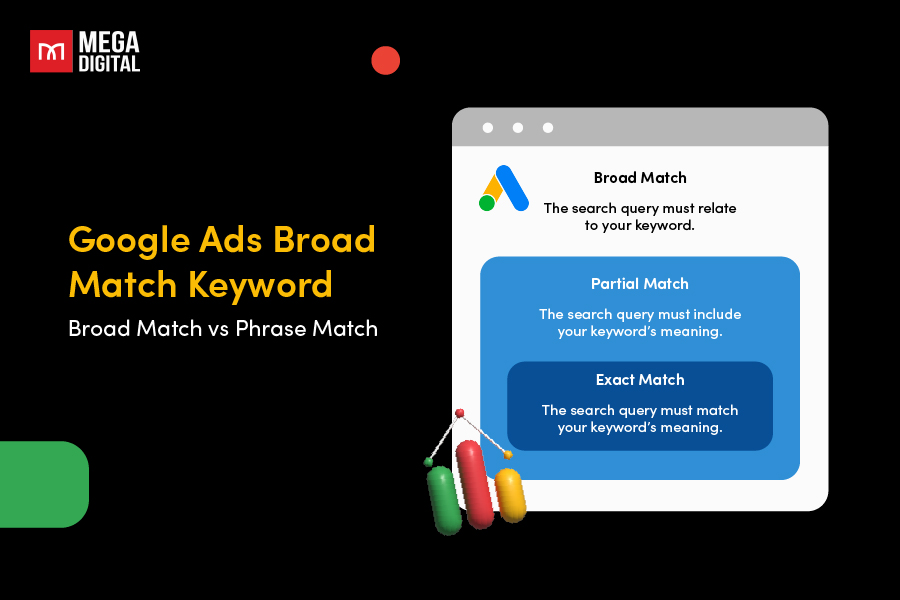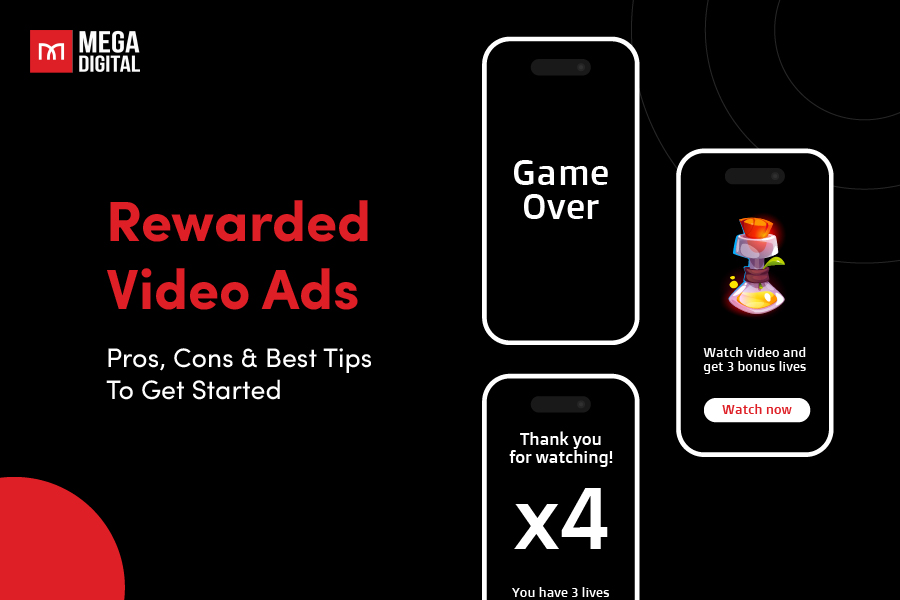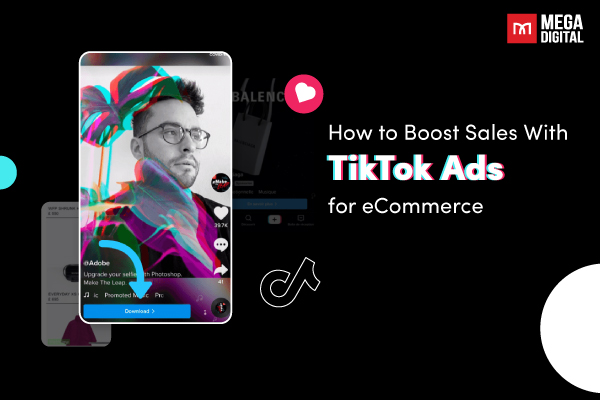Understanding the complexities of programmatic advertising can be overwhelming, especially with the rapid pace of change and the need for precise targeting. This blog post will break it down into manageable parts, exploring the different types, key best practices, and emerging trends to help you stay ahead in digital advertising!
- What Is Programmatic Advertising?
- How Programmatic Advertising Works?
- Types Of Programmatic Advertising Explained
- How Much Does Programmatic Advertising Cost?
- Programmatic Advertising Key Tools and Platforms
- Programmatic Advertising Best Practices for Your Brand
- What are Future Trends In Programmatic Advertising?
What Is Programmatic Advertising?
Programmatic advertising is the method for automated buying and selling of advertising spaces. It involves purchasing digital ad inventories across various platforms such as websites, mobile devices, apps, videos, and social media.
This enables the system to analyze multiple signals like shopping behaviors that will empower it to show the most relevant ads to the targeted audience in less than a second.

The programmatic advertising meaning is automating the decision-making for ads regarding the positioning and timing of their appearance. You don’t have to do everything using the traditional, manual efforts to buy ad space anymore.
How Programmatic Advertising Works?
Understanding how programmatic advertising works can be complex, but breaking it down helps clarify the process. This section will explain the programmatic ecosystem, including the key players and technologies involved, to give you a clear picture of how automated ad buying functions.
Programmatic Advertising Ecosystem Explained
There are 9 factors included in the programmatic advertising ecosystem, including:
1. Key Players
Two parties are working together to make the process of buying and selling ads efficient.
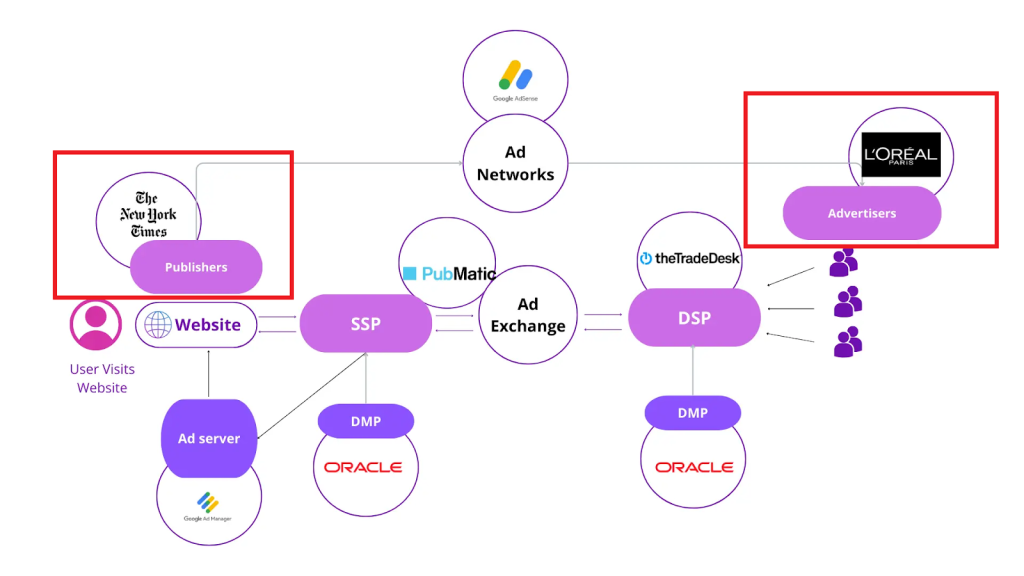
The advertisers, on the one hand, want ads shown. They might be brands, ad agencies, or programmatic advertisers who use automated processes in ad purchase and placement.
The publishers, on the other hand, own the platforms where the ads are placed. They can sell their own ad space directly to the advertisers. Or else, they will use a programmatic platform to automate the ad inventory selling process.
2. Demand-Side Platforms (DSPs) & Supply-Side Platforms (SSPs)
Demand-side platforms (DSPs) help advertisers manage the process of purchasing ad space through programmatic advertising. Since these platforms are operated by service companies, advertisers have to pay a fee to use the services.
On the other hand, supply-side platforms (SSPs) help publishers handle the sale of their available ad space programmatically. If publishers want to access SSP, they also have to pay.
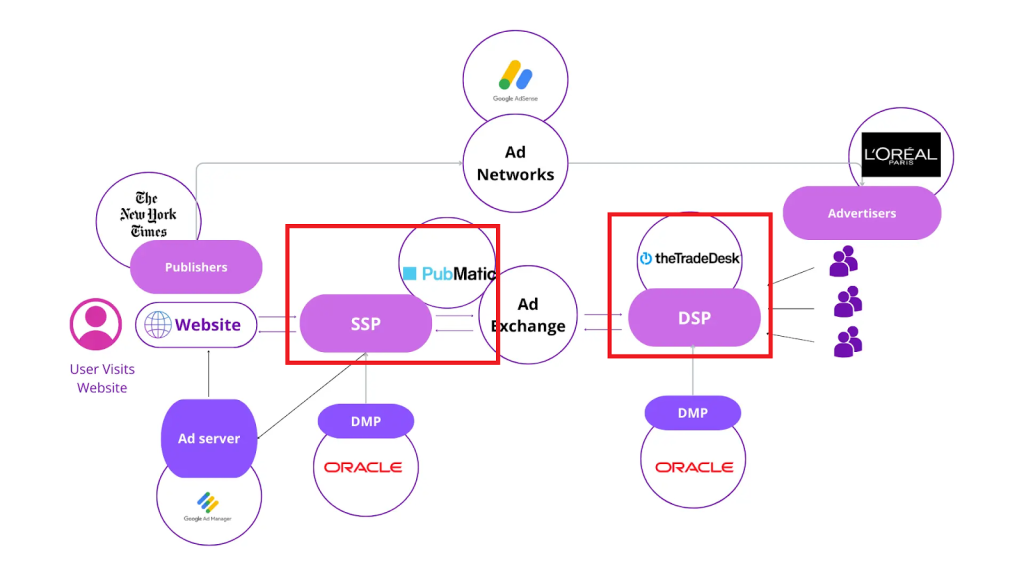
Although large advertisers and publishers sometimes develop their own DSPs or SSPs, the high costs usually discourage most companies.
3. Data Management Platforms (DMPs) & Customer Data Platforms (CDPs)
Data Management Platforms (DMPs) and Customer Data Platforms (CDPs) provide valuable data to enhance the automated process.
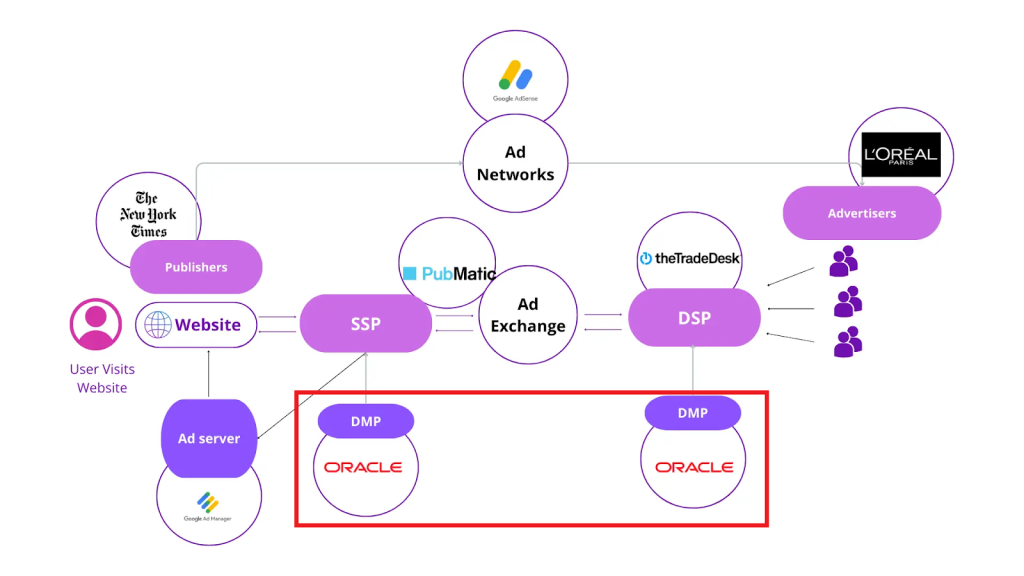
DMPs are large databases that gather third-party data. They help understand user behavior and preferences. However, as third-party cookies are being phased out, many DMP providers are rethinking their approach and transitioning to become CDPs.
CDPs store first-party data collected directly from customers and lead with their consent. Since this data is more privacy-compliant, its importance in programmatic advertising is growing.
Companies are also adopting techniques like identity graphing, which anonymously connects first-party data with other user information, providing a more secure and effective way to target ads in a cookieless environment.
4. Ad Networks & Ad Exchanges
Ad networks and ad exchanges are important intermediaries.
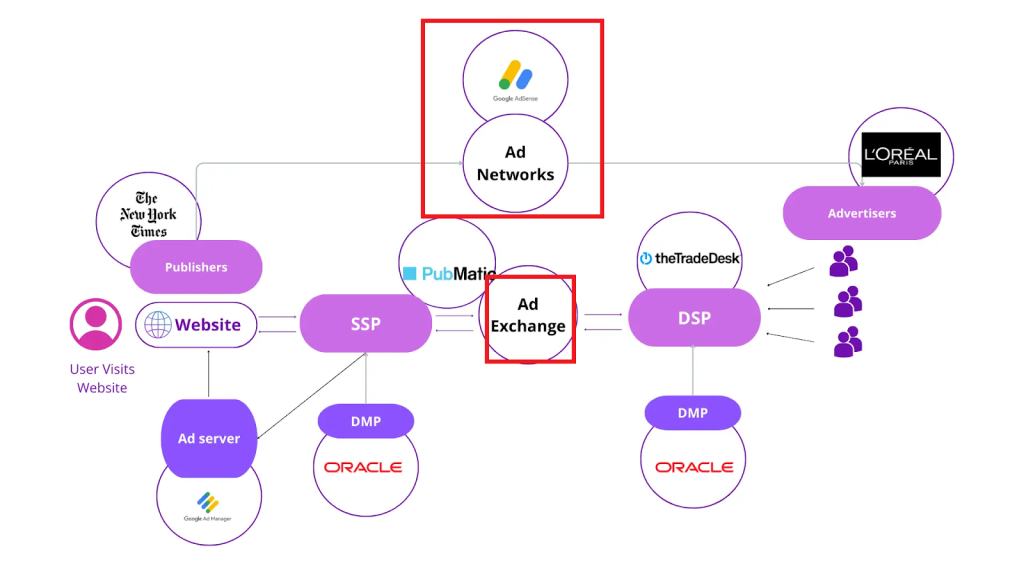
On the one hand, ad networks group ad space from multiple publishers, making it easier for advertisers to purchase inventory based on specific categories. These networks often use programmatic methods to help both advertisers and publishers achieve better results.
On the other hand, ad exchanges function without human involvement. It enables automatic buying and selling through a process called real-time bidding (RTB). Publishers and advertisers set their pricing and targeting criteria separately. When the conditions align, transactions will occur automatically.
Most modern ad exchanges are now integrated into SSPs, although this wasn’t always the case. Understanding the differences between these two entities can help clarify their distinct roles in the programmatic ecosystem.
>>> Read more: [15+] Best PPC Ad Networks Advertisers Should Consider in 2025
How Does Programmatic Advertising Work?
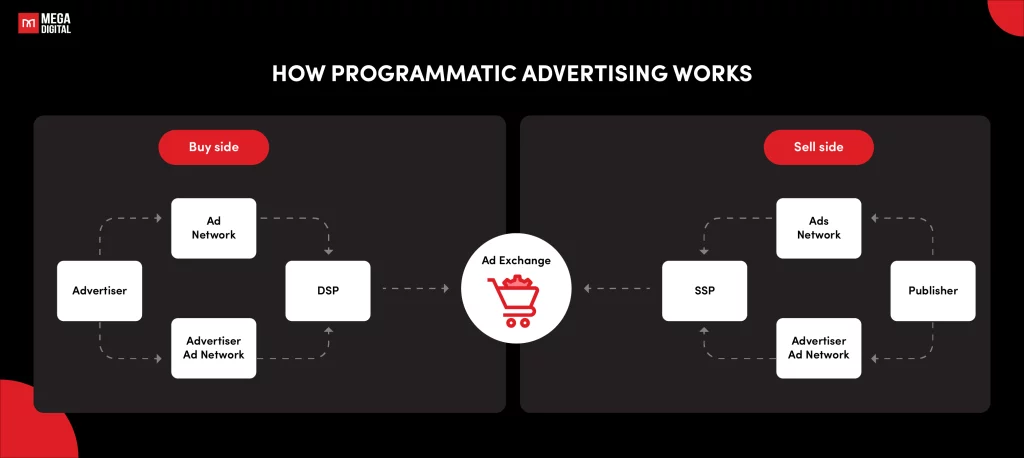
Programmatic advertising begins when a user visits a publisher’s website. Once the user’s web browser reads an ad tag from the site, an ad request is triggered.
This request is sent from the publisher’s website to the SSPs they are connected to. DMPs and CDPs may enhance the ad request by adding additional user information. The SSPs then forward the request to various demand sources, including ad networks and DSPs.
Once the demand sources receive the request, many advertisers place bids for the available ad space. Some advertisers also rely on their own DMPs or CDPs to refine the information before finalizing their bids.
After that, the SSP selects the highest bid and serves the winning ad on the publisher’s website. This automated system ensures the delivery of the most relevant ads to the right audience in real-time.
Types Of Programmatic Advertising Explained
Understanding the different types of programmatic advertising can help you make informed decisions. Here, we break down 4 key types to help you choose the best strategy for your brand’s needs.
1. Real-Time Bidding (RTB)
Real-time bidding (RTB) is the most common type of programmatic advertising. It is sometimes called an open auction, open market, or programmatic auction.
RTB is set up so that ad inventories go to all advertisers and the highest bidder receives the ad in real-time. Advertisers set a maximum bid amount and establish a budget for their campaigns. However, the winning bidder doesn’t pay their full bid. Instead, they pay just one cent more than the second-highest bid, making it an efficient way to purchase ad space.
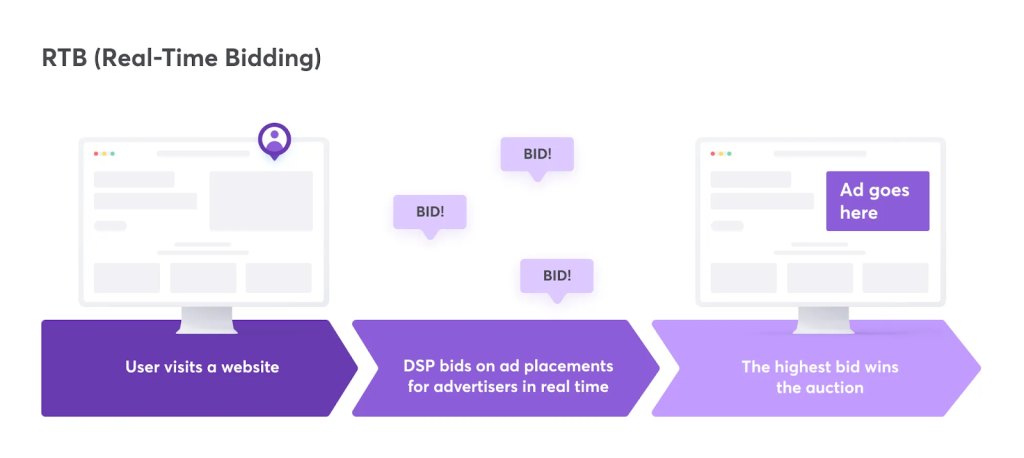
2. Private Marketplace (PMP)
A private marketplace (PMP) combines RTB with the benefits of direct agreements. Unlike open auctions, PMPs are exclusive and only accessible to selected advertisers invited by the publisher.
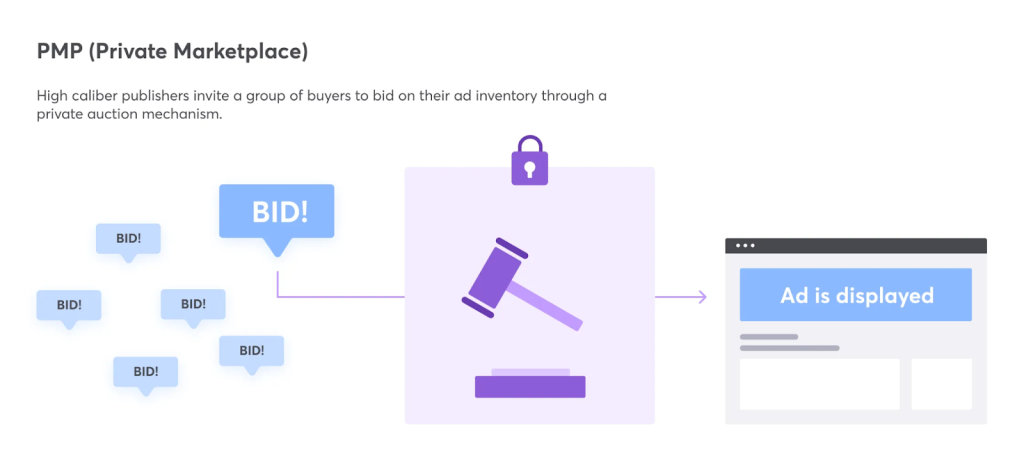
These marketplaces allow advertisers to bypass public ad exchanges and work with pre-arranged deal terms. Advertisers connect directly to a publisher’s available ad space and can bid based on various criteria, such as audience data, content type, or specific attributes that determine when and where ads are displayed.
3. Preferred Deals
In preferred deals, advertisers can access ad inventory at a fixed price before it becomes available on private marketplaces or open auctions. This approach, sometimes called spot buying, involves upfront negotiations where both the advertiser and publisher agree on pricing, targeting, and other terms.

Advertisers are granted early access to preview the publisher’s available ad space without any obligation to buy. Using a demand-side platform (DSP), they can assess audience data and decide whether purchasing a specific ad impression is worthwhile.
4. Programmatic Guaranteed
With programmatic guaranteed, also called programmatic direct, advertisers and publishers negotiate directly to set terms such as ad inventory, pricing, audience targeting, and frequency limits. Unlike other types, this approach does not use auctions, but ads are still delivered programmatically.
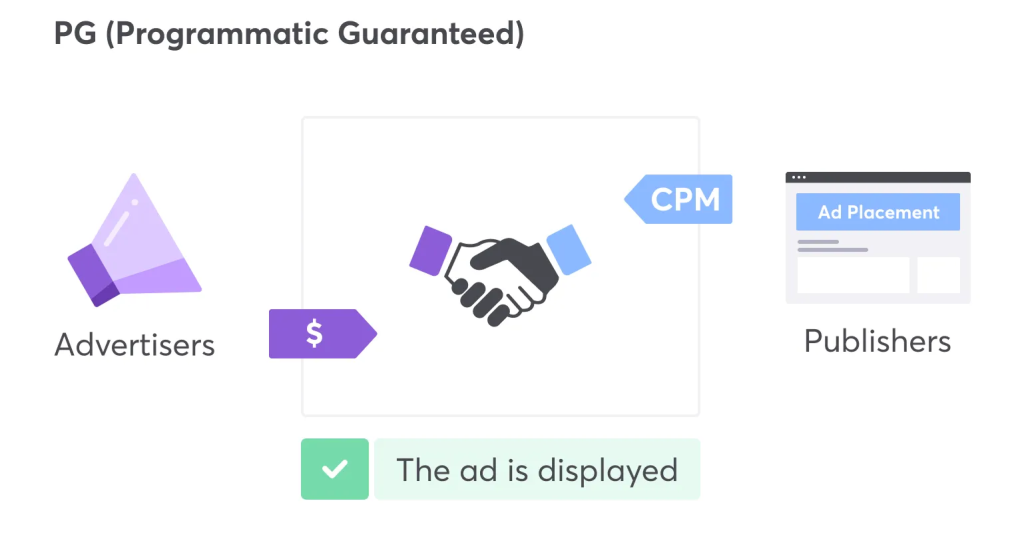
This method secures a set number of impressions on specific websites or mobile apps under a fixed-price arrangement. It is often used for high-value ad formats, like full-page takeovers. Due to its higher cost, advertisers typically choose this option when they need precise control over who sees their ads and in what context.
How Much Does Programmatic Advertising Cost?
The cost of programmatic advertising depends on factors like the ad type, audience targeting (like Google audience targeting), and market demand.
Pricing often uses cost-per-thousand-impressions (CPM), with video ads generally being more expensive than display ads. You can look at the average cost range in the table below:
| Types of Ad | Average Cost Range (CPM in USD) |
|---|---|
| Video Ads | $10 – $30 |
| Display Ads | $2 – $5 |
| Banner Ads | $1 – $4 |
| Native Ads | $5 – $10 |
| Rich Media Ads | $10 – $20 |
| Mobile Ads | $3 – $8 |
| Social Media Ads | $6 – $12 |
| Interstitial Ads | $4 – $9 |
| Retargeting Ads | $3 – $10 |
| Audio Ads | $8 – $15 |
The overall budget should cover not just ad costs, but also technology, data management, and creative services. By using industry benchmarks and past data, advertisers can set realistic campaign goals, balancing cost-efficiency and performance for better returns.
Programmatic Advertising Key Tools and Platforms
There is various platforms of programmatic advertising for the trading of digital ads. On the advertiser’s side, the major tools are Google Display & Video 360, The Trade Desk, and Amazon DSP are used to find and purchase ad inventory while targeting the right audience.
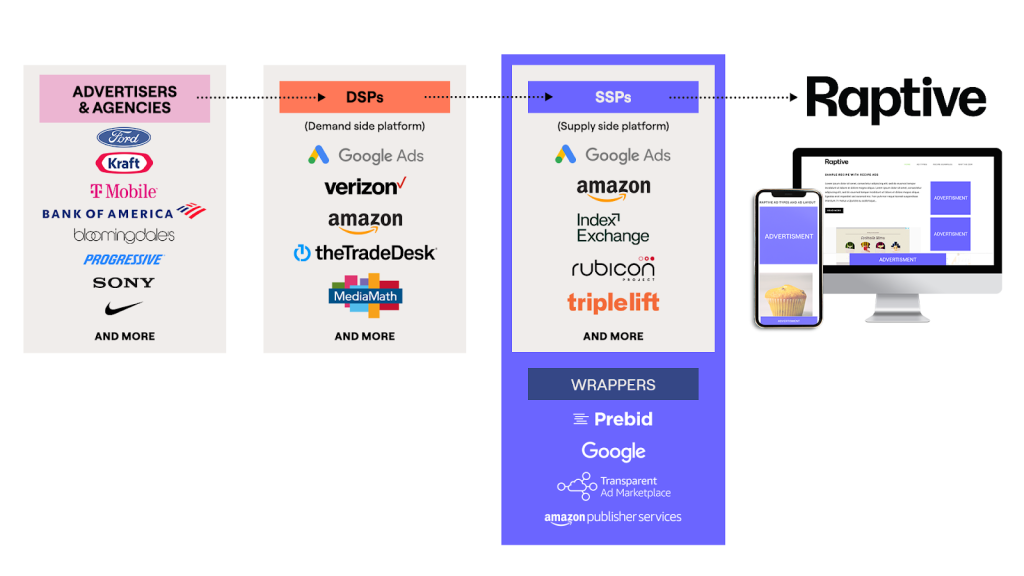
The publishers, on the other hand, prefer SSPs such as Xandr and PubMatic to manage and sell their advertising inventories. These platforms assist in communicating with the advertisers and securing the best possible deals.
Advanced targeting, detailed analytics, and automation provided by both DSP and SSP enable efficient and effective advertising campaigns.
Programmatic Advertising Best Practices for Your Brand
To make the most of programmatic advertising, it’s important to follow best practices that align with your brand’s goals. Let’s explore these key tactics below:
1. Leverage First-Party Data
First-party data includes information like website behavior, purchase history, CRM data, and customer feedback. It’s valuable for targeting specific audiences, personalizing ad content, and improving the customer journey.

For example, the data shows that a customer repeatedly purchases shoes. Thus, you can use that data to target them with personalized ads for related products like socks or accessories.
Using this data reduces reliance on third-party cookies and aligns with privacy standards. To implement it, you should invest in a DMP, ensure privacy compliance, and integrate your marketing tools with programmatic platforms.
2. Utilize AI-Powered Optimization
AI helps automate bidding, targeting, and creative decisions to streamline programmatic advertising campaigns.
For instance, a clothing brand could use AI to increase bids for jacket ads during the cold months. Then, the AI system detects increased searches for warm clothing when temperatures drop.
As a result, the system automatically adjusts the bid to place ads more prominently, capturing higher intent traffic. During warmer months, it reduces the bid to optimize ad spending and maintain a balance, ensuring the brand’s campaigns are more cost-effective and aligned with seasonality.
3. Prioritize Brand Safety
Protecting your brand in programmatic advertising is essential. Your ads should not appear on websites that promote harmful content, misinformation, or inappropriate material. To minimize risks, use tools like keyword blocking to prevent ads from being placed near sensitive topics.
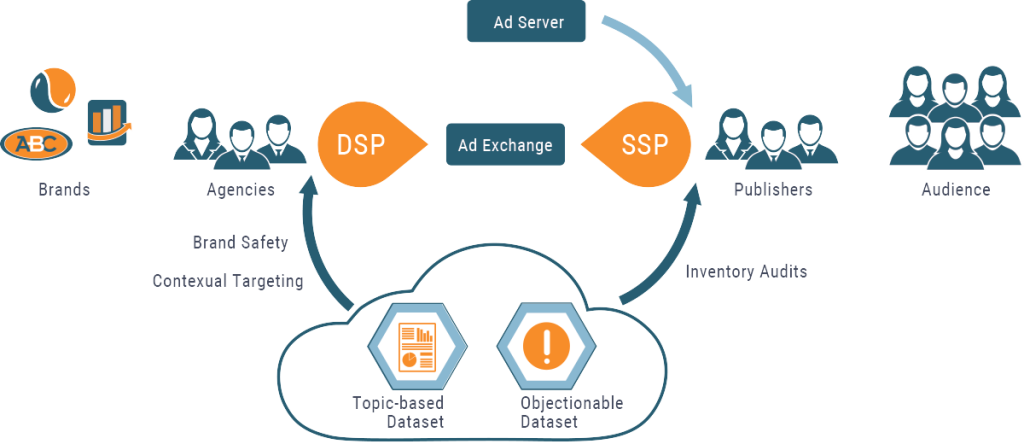
For instance, if you are advertising a family-friendly product, your ads must not appear alongside violent or explicit content. You should have a whitelist of approved websites to maintain credibility. Remember to monitor ad placements regularly so your brand remains in a safe and trustworthy environment.
4. Go multi-channel
Programmatic advertising allows brands to reach audiences across multiple platforms for a seamless experience.
For example, a sports apparel brand promoting a new running shoe can use video ads on YouTube to showcase performance benefits, mobile in-app ads on fitness apps to target active users, and DOOH ads on digital billboards near gyms. Audio ads on Spotify can reinforce the message by playing during workout playlists.
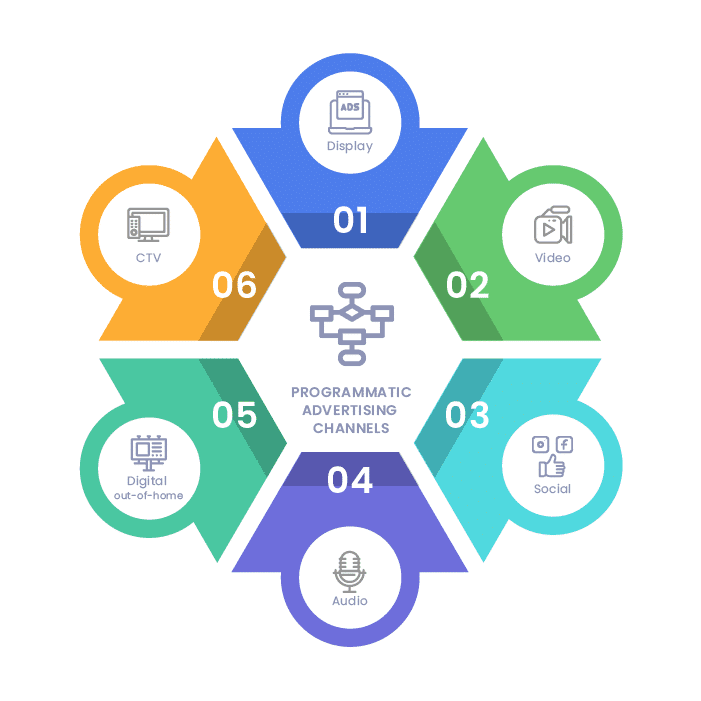
To execute effectively, brands should align messaging across channels, leverage a programmatic platform that supports multi-channel buying, and analyze performance for ongoing improvements.
5. Align Objectives With the Right Programmatic Platform
Not all programmatic platforms are built the same, so choosing one that fits your campaign goals is essential. For example, if you’re a luxury fashion brand targeting high-net-worth individuals, a platform offering premium inventory on sites like The Trade Desk or War Room would be a better fit than one focused on mass-market placements.
If AI-driven optimization is your priority, platforms like Google DV360 offer real-time bidding and predictive analytics. To ensure the best choice, define your goals, request demos, and test different platforms to compare performance.
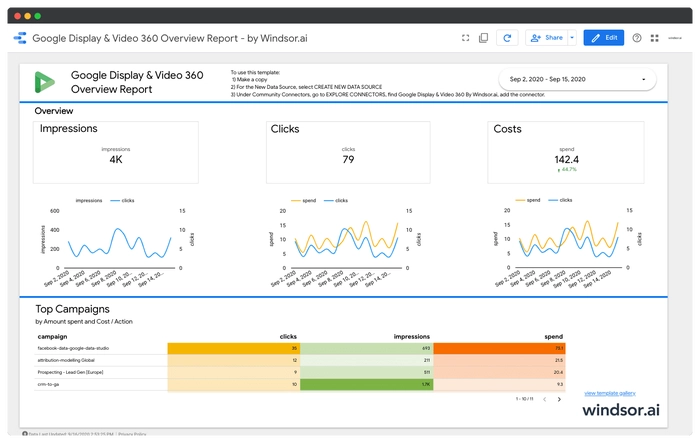
What are Future Trends In Programmatic Advertising?
So, as programmatic advertising continues to evolve, staying updated on the latest trends is key to success. This section will explore the future of programmatic advertising and how emerging trends are shaping the industry!
1. Video Advertising
Spending on video ads keeps increasing as video remains the dominant form of online content. In 2023, video made up 65% of internet traffic, with Netflix accounting for a significant share.
Advertisers in the US allocated nearly $74 billion to programmatic video ads in 2023, rising sharply from $52 billion in 2021. Since 2021, video ad spending has surpassed other digital formats, making automated buying the norm. As video continues to lead digital advertising, brands should explore top video ad networks to maximize impact.
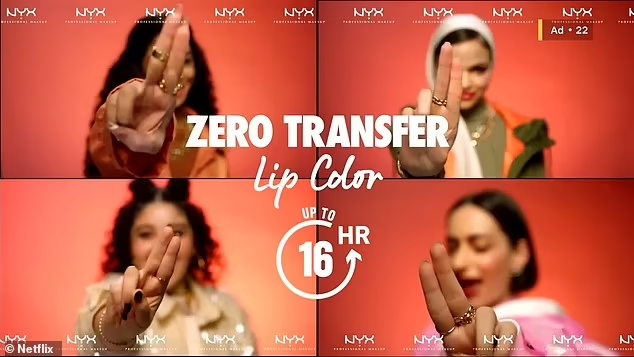
2. Privacy-Centric Advertising
Advertising starts to focus more on privacy as consumers demand more control over their data. Marketers now prioritize transparency and user consent in their data strategies.
One approach is data anonymization, where personal identifiers are removed to protect user identities. Another is differential privacy, which introduces small modifications to data to maintain privacy while preserving useful insights.
Meanwhile, federated learning allows multiple devices to train AI models without sharing raw data, keeping information secure while improving ad targeting. These methods help balance effective marketing with user privacy.
3. Cross-Device Advertising
People switch between multiple devices daily. To optimize ad campaigns, brands have to track customer interactions across smartphones, tablets, and desktops.
Cross-device attribution helps advertisers understand users’ engagement with different touchpoints before making a purchase. Advanced tracking models analyze device-switching behavior, allowing marketers to allocate budgets more effectively and improve ad performance.
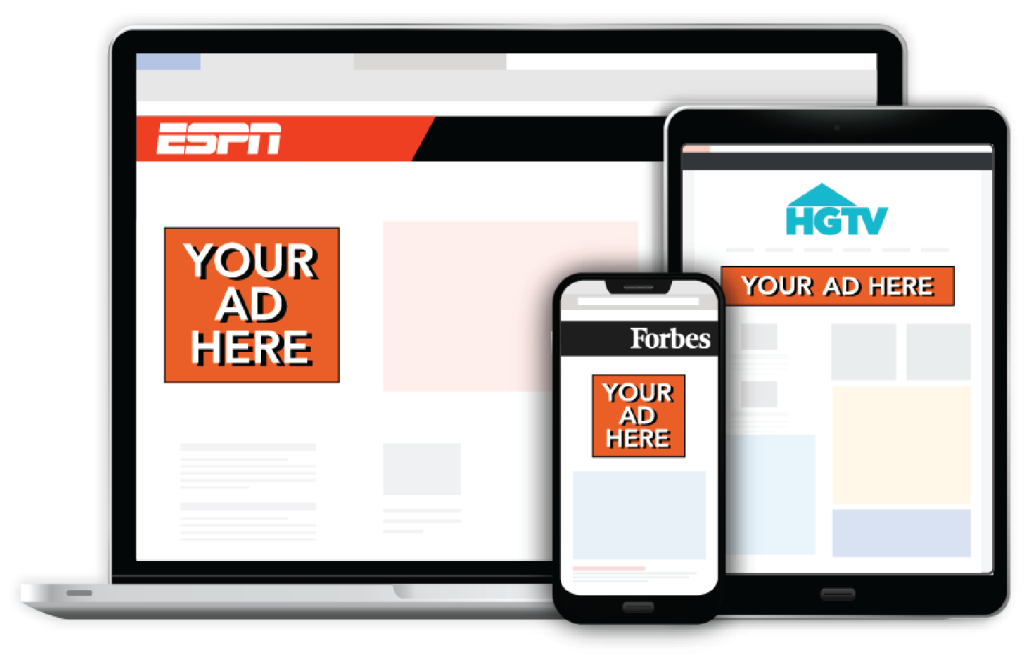
Beyond better measurement, cross-device advertising creates a seamless experience for users. It ensures consistent messaging across devices and enables sequential storytelling, guiding customers through the buying journey in a personalized way.
4. Contextual Targeting Services Availability
As stricter privacy laws limit traditional audience tracking, contextual targeting is emerging as an effective alternative. Instead of relying on personal data, it analyzes the surrounding content where ads appear, such as web pages or social media posts.

Advancements in AI-powered language processing help brands understand content intent, ensuring ads match relevant topics. This approach improves ad relevance and user experience by reducing ad fatigue. As privacy concerns grow, contextual targeting will likely become a preferred strategy for delivering personalized, high-impact advertising.
Wrap Up
Programmatic advertising is evolving fast. Hence, understanding its functions, best practices, and future trends is crucial for staying ahead. By implementing these insights and strategies, brands can improve targeting, efficiency, and overall ad performance. Keep an eye on emerging trends and adapt your approach to drive more impactful and successful campaigns.







